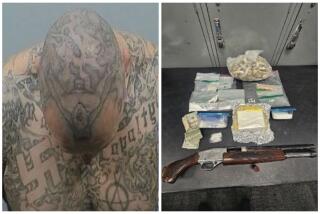Black Prison Gang Moves In on Cocaine Trade
Southern California law enforcement officials have become increasingly concerned about the growing presence of the Black Guerrilla Family prison gang on the streets of South-Central and Southeast Los Angeles.
At least two murders have been linked to an organized attempt by the gang to move in on the lucrative cocaine trade in the Watts areaâs housing projects, where some residents fear that recently paroled prison gang members are trying to establish a foothold.
Alarmed by the violence--and by widespread rumors that Black Guerrilla Family members are stockpiling weapons--state Board of Prison Terms members met with Los Angeles police detectives last month to discuss what actions the board can take to thwart the gangâs activities outside the prison walls.
âThey are apparently learning that controlling cell blocks is not nearly as much fun as controlling blocks in the city,â said Bob Carter, a former Los Angeles police lieutenant who is now a member of the Board of Prison Terms and the organizer of the meeting. âThey are doing everything they can to lay low in the prison and get involved in the action back on the outside.â
The Black Guerrilla Family, estimated to number about 400 members within California prisons and about 200 on the streets of Los Angeles, was formed in the late 1960s and early â70s at a time when white and Latino prisoners were also organizing into gangs.
Black Guerrilla Family members were initially characterized by prison officials as having tight internal discipline and a left-wing political ideology which held that blacks were essentially political prisoners.
Political Beginnings
Authorities said the group, which had ties to the Black Panther Party and Symbionese Liberation Army in the mid-1970s, once had a political strategy that included plans to kidnap Department of Corrections officials. In addition, the group was believed to have developed an intelligence network that tracked the movements of police officers throughout the state.
But as the group evolved, a faction made up primarily of prisoners from Southern California became more concerned with organizing around street crime instead of revolutionary politics.
A group of suspected Black Guerrilla Family members once thrived in the Pasadena area, but that contingent has diminished since the 1979 arrest of James H. (Doc) Holiday in connection with a drug-related double homicide in Pacoima. Holidayâs first trial ended in a hung jury. He is still in Los Angeles County jail awaiting a second trial.
Police and parole officials, who have long kept close tabs on suspected Black Guerrilla Family members released from prison, again grew nervous about the organizationâs street activities last March when two murders at the Nickerson Gardens housing project allegedly resulted from Black Guerrilla Family attempts to establish itself in the areaâs drug-trafficking market.
Three Nickerson Gardens residents recently paroled from state prison were arrested on April 4 for the murders of Elbert Robinson, 25, and Earl Hanzy, 26, at the project. Taken into custody were Michael Dorrough, 31, described by police as an admitted Black Guerrilla Family member, and two associates, Andre Mathews, 30, and Herman Coleman, 29. All three suspects are awaiting trial in Compton Superior Court.
One source in the city Housing Authority, which runs the project, said that despite the arrests, it is a common belief among residents in Nickerson Gardens that the Black Guerrilla Family is still behind much of the drug trafficking in the sprawling housing complex.
âThe LAPD has caught some of them, but they (the Black Guerrilla Family) are here, and they have their activities going on,â said the source, who asked that his name not be revealed.
One project resident, who also asked that her name not be printed in fear that she might be harmed, said she was paid $300 a week to allow the prison gangâs operatives to sell rock cocaine from her Nickerson Gardens apartment.
âThey pay very well, as long as theyâre making money themselves,â the woman said. âThey were bringing in three grand ($3,000) a night at my place.â
The woman said Black Guerrilla Family members do not hesitate to use violence against individuals they suspect of crossing them in drug deals or cooperating with the police.
âTheyâll smile in your face and kill you with a grin,â she said. âTheyâll kill you like nothing.â
Shortly after the arrests of Dorrough, Mathews and Coleman, the Board of Prison Terms called for the meeting with Los Angeles Police Department detectives specializing in prison gang activities to discuss suspected gang crimes here and in Oakland, where the organization is also believed to be involved in drug trafficking and related violence.
Back Into Action
âWe are receiving reports that BGF members are going back into their communities, particularly in Los Angeles, and becoming involved in street crime and engaging in disagreements with local community gangs over territory and control of illegal activities in those areas,â said Bill Elliott, executive director of the Board of Prison Terms.
âIn reviewing these reports, you get a good idea that there is some significant activity going on out there,â he added.
Detective Jim Vuchsas of the Police Departmentâs prison gangs unit estimated that about 200 suspected Black Guerrilla Family members are living in Los Angeles. That figure represents an increase of about 50, or 33%, from a year ago. Vuchsas attributed the increase to the number of parolees released from state prison in the past year.
The gangâs influence, however, extends far beyond its actual numbers, according to law enforcement sources. They said the Black Guerrilla Family has been making contact with the estimated 1,500 black street gang members from Los Angeles inside the prison system and successfully recruiting the younger ones to sell drugs and engage in other crimes for the gang when they are released.
Pattern Developing
Detective Bob Nelson, another Los Angeles police prison gang investigator who attended last monthâs parole board meeting, said the gangâs involvement in drug trafficking and violence on the cityâs Southside is âa pattern thatâs been developing over the last year.â
Moreover, some suspected members âseem to be very active in obtaining sawed-off shotguns and assault-type rifles,â Nelson said, adding that he has received numerous tips that gang members are stockpiling weapons.
None of those leads have been substantiated, âbut we keep hearing information about it,â Nelson said. âItâs rumored they have an armory.â
Received Same Information
Dan Mariani, supervisor of the Department of Correctionsâ parole office in Huntington Park, which handles ex-convicts living in Watts and the surrounding Southeast Los Angeles area, said his office has received the same information about Black Guerrilla Family weapons caches.
Mariani said that if the rumors are true, it could mean that the group is preparing for a battle with competing drug gangs that are already entrenched in the South-Central area.
âIt that happens, all hell would break loose,â Mariani said.
More to Read
Sign up for Essential California
The most important California stories and recommendations in your inbox every morning.
You may occasionally receive promotional content from the Los Angeles Times.










